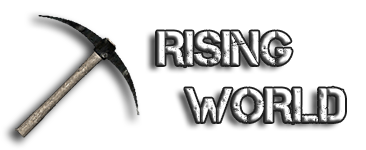With the last few updates being geared more towards survival (water, canteens, and fuel requirements) and with primitive tools just around the corner, I'm introducing a new suggestion list for primitive crafting. This is based mostly on my own thought but includes some other ideas I remember others suggested elsewhere. Some I'm repeating just incase Red didn't see or maybe to persuade him further to re-consider (seeing that the game development is partially community inspired).
Naturally spawning objects
- So if anyone is not aware, naturally occurring sticks and stones are already confirmed to be coming
- natural sticks should spawn or re-spawn randomly on the ground in proximity of trees but only after sleeping -- similar to The Forest
- natural stones same general behavior as above but probably spawn near cave entrances, inside caves, and near water bodies
- A river rock variation of the above might be more suitable for crafting weapons
- Animal bones (individual bones found scattered or salvaged of a carcass)
Other crafting mechanic changes
- add alternative ingredients for a crafting recipe (see primitive campfire section below for example)
- Either barehanded or having a tool equipped (either the active hotbar slot or being barehanded if implemented) affects some recipes (like RUST)
- Remove/Replace the "drop" command (key_Q) and change it to unequip (go barehanded).
- Pulling grass is only done by hand so press Q or select a slot with no item (same behavior as ARK)
- Pulling grass is useful for clearing very small patches of glass around stuff like furnaces when placed on grass since now possibly finding the side door is an issue in tall grass
- Pulling grass by hand removes very very small about of grass (1/10th the area of a sickle swipe) . First pull makes the grass it half-height, second pull removed long grass, third pull turns the ground from grass to dirt (obviously this is going to be a very tedious process but useful for minor land changes and gathering plant fibers)
Tool Stone
- I'm bringing this up again even though I don't think Red51 is keen with the idea yet.
- River rocks or possibly rocks found in caves can be crafted into a handheld "cutting tool"
- Two rocks = 1 cutting tool
- Cutting tools may also be occasionally found inside caves left over by past civilizations (pretty sure Red confirmed possibly finding old artifacts embedded in stone or in old clay jars (like Terraria?). some items scattered in caves might be good too)
- A river rock + 1 cutting tool = 1 punch tool (cutting tool destroyed in the process)
- Punch tool + natural stick + plant fibers = primitive axe
- cutting tool + natural stick + plant fibers = primitive pickaxe
Animal decomposition and salvaging
- Animals that we don't "hide" after killing will decompose in a few different stages (each stage advances with the passing of each day)
- 1st stage of decomposition spoils any meat left but can still salvage organs or hide for crafting recipes
- 2nd stage of decomposition only bones are remained.
- dead animals (not the ones we kill) will naturally respawn only after sleeping (because bear attacks happen in the wild)
- Each passing day (regardless of our decision to sleep) will decompose a dead animal further. So eventually we will have only animal bones here and there to pick from
- The tool we are holding (club, axe, pickaxe, or knife/shiv) determine what inventory shows in the carcass and its quality and quantity. So if you arent happy with the inventory (meat, bones, entrails, hide) close the animal's inventory window and hold a different weapon and open it again (since I doubt we will be harvesting by hacking the inamial since the inventory window is already established for animals)
Primitive camp fire
- Modify ingredient requirements and implement alternative crafting ingredients (useful for primitive crafting only)
- One log can be substituted for several natural sticks
- loose river rocks or cave rocks can substitute stone (currently mined)
Primitive knife
- a large animal bone can be collected off of dead animals at any stage of decomposition
- crafting a camp fire and cooking pot is required (should be anyways for boiling water)
- A bone with marrow is dropped into boiling water to remove marrow and become a hollow bone
- If you happen to get a hollow bone from a carcass (possibly after further decomposition) then you can skip the cooking pot step
- bone is crafted into a shiv assuming you have a cutting tool
Starting out
- When we start out bare handed, the only craftable items should be a primitive pickaxe and axe (or the cutting tool if Red51 gets onboard)
- Same rule above applies with making sticks
- An axe or pickaxe or cutting tool must be equipped in order to craft a torch holder
- An axe must be held in order to craft lumber
- A torch can still be crafted from a natural stick (perhaps a new model could be added. The natural stick torch can fit in any torch holder)
- Holding an axe or other tool is required for crafting new items on the workbench
- As an alternative to the last thought, equip a workbench with tool slots. That way, tools can be stored on the workbench so you don't have to be dependant on the tool you are currently holding.
- Any crafting causes a tool to wear (either the one held or the ones stored on the workbench)

